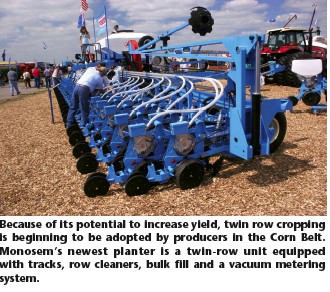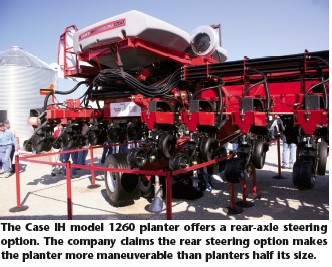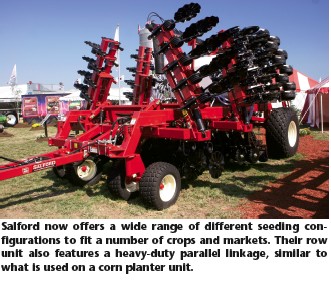More options, flexibility and precision are hallmarks of the newest planters introduced during the Farm Progress and Big Iron shows.
The rapid rise in the cost of seed and fertilizer in the past year served as a wake-up call for farmers, reminding them that controlling input costs is often the difference between being profitable or not. For grain farmers, this means getting the most from their planting and fertilizing efforts. It was apparent at the 2009 Farm Progress Show that equipment manufacturers also got the message.
At this year’s show, held the first week of September in Decatur, Ill., much of the newest and most advanced equipment involved planting and fertilizer placement technologies. While fertilizer prices have fallen significantly from where they were 12 months ago, growers are still anticipating future increases.
As a result, they’re scrutinizing their options and looking to place fertilizer within and/ or alongside the row during planting. These placement options will minimize nutrient expense and reduce overall operating costs, while maintaining yield benefits.

Encouraged by announced increases in seed prices, many growers are looking to upgrade planting or seeding equipment. Early 2010 pricing suggests that a bag of SmartStax corn may reach or exceed $330 per bag. And with increased nitrogen utilization and drought-tolerant genes coming soon, this is expected to push seed corn over $400 per bag. Soybean seed is also expected to rise, with indications that treated seed is heading for $70 per unit next year.
As a result, producers will be turning to equipment dealers for guidance in selecting the most efficient and accurate seeding systems to ensure optimal placement and control of the planting process. This article looks at the trends in seeding operations and reviews the cutting-edge planting equipment shown at the 2009 Farm Progress Show.
Seed & Fertilizer Placement
With the drive toward increasing productivity per unit of labor and reducing passes across the field, the most advanced seeding equipment is engineered to let the planter place seed and deliver fertilizer products simultaneously.
While placing all fertilizer at seeding time, especially nitrogen (N), may not be the most appropriate decision in higher rainfall areas, placing some of the crop’s needed N requirements with phosphorus (P) and/or potassium (K) alongside the row has shown significant yield advantages.

Many farmers that practice conservation tillage are finding RTK-guidance systems are required to position crop rows directly on top of strip-tilled bands, especially with rolling land.
While RTK is effective, it’s not necessary when applying fertilizer at seeding time because frame- or unit-mounted fertilizer openers and row units are close enough together to maintain consistent placement. This helps increase overall fertilizer recovery, compared to broadcast applications.
Newer planters and drills are better equipped to handle wider variations in soil, moistures and residue. Many are designed to add a variety of attachments to place fertilizer and to move residue aside with row cleaners. Such attachments were often difficult to add to older equipment.
Adopting Twin Rows
Producers across the Corn Belt are also adopting twin rows as a system to increase yield potential. Momentum in this direction appears to be gaining strength as research suggests higher yield potential can be created as a result of improved light, soil, nutrient and moisture utilization. Twin rows offer producers an alternative to 30-inch rows without significantly changing harvesting or spraying equipment, which would be required for 20-inch rows.
Monosem and Great Plains are the two major players in the twin-row market. Research studies across the Midwest and Central Plains are demonstrating that twin rows can increase yields compared to single 30-inch rows, especially when crop management practices are pushed to the next level. These management steps may include increasing plant population and fertility rates, along with selecting corn hybrids with an agronomic package suitable for higher populations and higher yield environments.
Advancements have taken place in recent years in plant breeding that will accelerate the growth of twin-row corn. These include better stalk quality, enhanced standability characteristics, improved disease control and insect resistance. The trend of using foliar fungicides on corn has already helped push corn populations higher while improving yield potential without compromising plant health.
Twin-Row Planters
Monosem introduced their new 24 x 30-inch twin-row planter at this year’s Farm Progress Show and it attracted a lot of attention. This variation adds tracks to reduce soil compaction at planting, central fill for faster seed handling, residue managers for conservation planting along with the Monoshox shock absorbing system.
Monoshox is a patented system that keeps planters level in rough terrain and no-till environments. A vacuum metering system with a stainless steel seed disc improves placement with a wide range of crops.
Don Niehs, U.S. marketing manager for Monosem, sees a strong future for twin-rows and higher yields. He says additional benefits include earlier canopy closure, better weed control, improved light interception and enhanced nutrient recovery.
Higher yields have also been found to come from the equipment’s method for staggering seed drop, which alternate seeds between each row, and allows plants more room to grow. Niehs adds that twin rows also help improve singulation accuracy because the seed meters are turning at only half the speed of a 30-inch row planter at the same population. This becomes important as producers look to higher planting speeds.
Great Plains has also been a prominent proponent for twin-row practices and recently introduced a number of new products. One of the more popular lines includes the twin-row Yield-Pro (YP) planter series.
These planters couple the benefits of twin rows with a choice of seed box handling systems that hold 50 bushels or poly hoppers that hold 82 or 150 bushels of seed. YP planters also feature an optional pair of 200-gallon liquid fertilizer tanks for starter fertilizer or supplemental nitrogen.
The YP planters offer staggered seed delivery that positions seed in an exact triangle and allows more than 40% of coverage before roots compete for space with a 38,000 corn plant population. This compares to about 18% of coverage before roots will compete in a normal 30-inch row program.
Great Plains also introduced the new Air-Pro seed meter that features a positive Indicate No. 127 on inquiry card or air system. Both vacuum and or positive-air systems have been found to improve seed placement across a wide range of forward speeds, seed sizes, seed shapes and seed treatments.
However, the company claims the Air-Pro system is easier to maintain and requires less hydraulic oil capacity. Because the fan on YP planters delivers air to both the seeddelivery system and seed meters, hydraulic flow is reduced to 18-22 gallons per minute.
Options & Flexibility
Another trend in the planting and seeding equipment introduced at the Farm Progress Show is more options and wider flexibility that are being designed into the newest generation of planting systems.
Among Kinze Manufacturing’s newest row-crop planters are the 3660 Twin-Line planter and two-section Twin-Line planter in 12- or 16-row configurations with 30-inch row spacing and mechanical or Edge-Vac seed metering systems. Air seed delivery (ASD) or conventional seed hoppers are available with hydraulic weight transfer to shift weight from the center section to the wings.
Typically, planters have most of their weight on the center section that can leave more wheel tracks than farmers consider acceptable. The weight transfer option is particularly useful when planting into soft soils.
The 3660 Twin-Line is equipped with 30-inch spacing corn units at the rear and 30-inch soybean units at the front. It underlines Kinze’s efforts to build more flexibility into its equipment as this allows producers to plant corn on 30-inch rows with the rear units, or 15-inch split rows using both front and rear units.
To help manage residue in no-till fields, Kinze planters can be equipped with row cleaners. For producers wishing to place fertilizer in a band alongside the row, the company offers a heavy-duty frame-mounted fertilizer opener.
Rear-Axle Steering
Case IH unveiled its new 1260 planter earlier this year. This model features a number of options to meet market demand. These include 32- and 36-row 30-inch, 36-row 20-inch and 36-row 22-inch configurations. Each model includes the Early-Riser row unit and ASM seed metering system that has performed well across a number of seed sizes, seed shapes and forward speeds.
The 1260 on display at the Farm Progress Show also had a rear-axle steering option, which Case IH claims makes the planter more maneuverable than planters half its size. This model has caster wheels on the wings, significantly reducing the tongue weight to 2,200–3,200 pounds.
Seed-Sensing System
Precision Planting continues to design products to help farmers achieve the picket-fence stands required for high yields. Released this year is the WaveVision seed sensor that mounts in the bottom of the seed tube.
The system utilizes a different method of sensing, which enables it to monitor seed density and more accurately discern between double and single seeds dropping down the seed tube.
It also distinguishes between foreign material and dust, both of which can influence the population readout within standard sensing systems. This was demonstrated by dropping graphite down both seed tubes and showing how it influences the number of seeds measured by both a standard seed sensor and the Wave Vision system.
Wheat & Soybean Drills
Salford introduced its 520 air seeder that features heavyduty double disc openers with a parallel linkage system to help maintain the angle at which that the opener enters the soil. Each opener delivers up to 500 pounds of down-pressure per row.
The opener is equipped with seed firmers, soil control straps and a simple system of brackets mounted on each side of the opener to help reduce soil disturbance when operating at higher speeds.
This seeder offers growers the flexibility of using wavy no-till coulters up front or lifting them when coulters are not required. The Salford seeding series has a wide selection of working widths that include 15-foot solid, 20-foot solid or folding, and 22-, 25-, 30-, 35- and 40-foot folding models. Each can utilize a 6-, 7.5-, 10-, 15- or 20-inch row spacing.
Landoll rolled out its new 30-foot 5530 and 40-foot 5540, 3-section, front-folding doubledisc drills. These drills are available with 7.5- or 10-inch row spacing and a hopper capacity of 3.25 bushels of seed per foot of working width. Soil control straps on each opener reduce the amount of soil movement when working at higher speeds or with loose soils.

While these drills don’t include parallel linkage on each opener, they’re equipped with pneumatic down-pressure adjustment between 120-400 pounds per row, depending on ballast and row spacing. The company says the system delivers a more uniform down-force across the working range of the opener.
New Stack Toolbars
The Orthman 925 stack toolbar made its debut at this year’s Farm Progress Show, and represents a joint venture between Orthman Manufacturing and John Deere. The configuration on display was a 3-point mounted 16-row by 40-inch hydraulic folding toolbar, designed for ridge-till systems, but many other row and working width configurations are available. It offers the maneuverability of a mounted planter system coupled to Deere’s XP row units and the bulk-fill CCS seed delivery system.
Big & Bigger Planters
Planting equipment has continued to get bigger to match the needs of the largest acreage growers. While 99.9% or more of the U.S. market may never justify a 48-row 30-inch (120- foot wide) planter, nothing makes a grower stare more than viewing John Deere’s 40,000-pound engineering achievement.
The number of acres planted per hour with the DB 120 planter is only dwarfed by its price tag. But as farms get bigger and labor becomes more difficult to find and retain, the demand for wider planters for large fields will increase.
This unit comes standard with the CCS refuge plus system to help farmers comply with refuge requirements for insect-resistant corn hybrids. The DB 120 also has 125 bushels of bulk seed capacity, enabling growers to plant 300-400 acres per fill.
Independent Coulter Drill
While most new innovations for 2010 were introduced at the Farm Progress Show, Bourgault Industries chose to roll out its new 3710 independent coulter drill at the Big Iron Show in Fargo, N.D., in mid-September.
This new air-seeder brings several industry “firsts” to the air-seeding market to help larger producers establish crops faster and more efficiently. One of the noteworthy features of the 3710 is the parallel linkage arrangement on each opener. This allows 7 inches of upward travel and 9 inches downward travel, for a total of 16 inches of terrain following capability.
Compared to other radial arm design single disc openers, the parallel linkage arrangement allows the disc, boot and closing system to work effectively across a wide range of topographies.
Also included is hydraulically adjustable downforce and greater working widths than other single disc seeder models. Current versions are offered in 7.5-, 10- and 12-inch spacing, and working widths of 40, 50 and 60 feet.
This newest seeder also offers a set of mid-row banding openers that allow fertilizer products to be placed between each pair of rows in mid-row bands to boost yields especially in lower rainfall areas.






